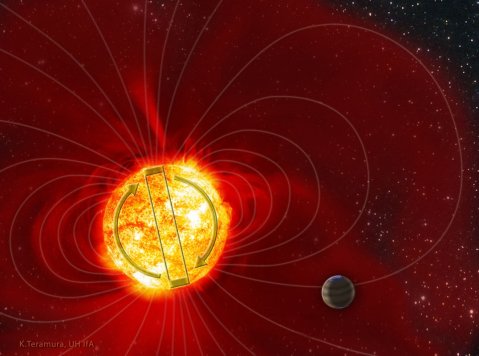First glimpse of star flip

An international team of astrophysicists has, for the first time, discovered a star other than the Sun flipping its north and south magnetic poles.
The discovery, which involved researchers from the University of St Andrews, could help astronomers develop a better understanding of the “magnetic engine” of the Sun.
Professor Andrew Collier Cameron and Dr Moira Jardine from the University’s School of Physics and Astronomy were amongst the researchers who caught the star “tau Bootis” flipping its magnetic field from north to south.
It has been known for many years that the Sun’s magnetic field changes its direction every 11 years, but this is the first time that such a change has been seen in another star.
The group of astronomers, led by Jean-Francois Donati and Claire Moutou of France, observed the star in the process of flipping its poles whilst they were mapping the magnetic fields of stars. They are now closely monitoring tau Bootis to see how long it will be before the magnetic field reverses again.
As the astronomers managed to catch tau Bootis in this state of magnetic flipping during just two years of observations, they believe it is likely that this event is much more frequent on tau Bootis than it is on the Sun. The shortened cycle of this event may be due to interactions with a nearby massive planet.
Dr Jardine explained, “This is a fascinating observation for lots of reasons. It has given us the first glimpse of how other stars flip their North and South magnetic poles.
“It also suggests however that massive planets may be able to influence the magnetic cycles of their stars.
“This is a real David and Goliath situation – normally we think Sun-like stars might influence their planets, but here it seems that the planet is in the driving seat.”
The astronomers aim to develop a better understanding of how magnetic engines work in stars, including our Sun and will keep their telescopes focused on tau Bootis and its magnetic turnovers in coming years.
The star is slightly hotter and 20 percent more massive than the Sun. It is quite bright and visible with the naked eye and is located 51 light-years away from earth. It currently rises about midnight and is visible for most of the night near the bright star Arcturus in the constellation Bootis in the northeast part of the sky.
This work is published in the current British journal Monthly Notices of the Royal Astronomical Society and should help scientists understand better how magnetic engines work in stars like our Sun. Details are available at: http://xxx.lanl.gov/abs/0802.1584
ENDS
NOTE TO EDITORS:
Dr Moira Jardine is available for interview. Telephone: 01334 463146 Email: [email protected]
Magnetic field reversals on the Sun are closely linked to the varying number of sunspots seen on the Sun’s surface. The last “solar minimum”, the time when number of sunspots was the lowest and the magnetic flip occurred, was in 2007. The first sunspot of the new cycle appeared just last month.
The magnetic cycle of the Sun impacts the Earth’s climate and is believed to have caused the little ice age in the seventeen century. The Earth’s magnetic field also flips, although much less frequently and more erratically.
NOTE TO PICTURE EDITORS:
IMAGES ARE AVAILABLE FROM THE PRESS OFFICE : CONTACTS BELOW. PLEASE CREDIT: “Art by Karen Teramura, University of Hawaii Institute for Astronomy”.
Issued by the Press Office, University of St Andrews
Contact Fiona Armstrong, Press Officer on 01334 462530 / 462529, email [email protected]
Ref: Star Flip 260208
View the latest University press releases at www.st-andrews.ac.uk
Category Research